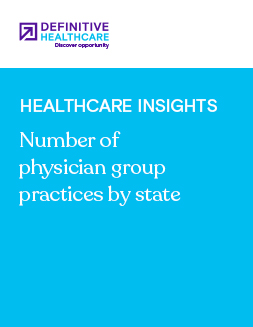Healthcare Insights
How many surgery centers are in each state?
When a patient needs surgery that requires overnight observation or a guided inpatient recovery, the hospital has the resources and personnel necessary to ensure the best outcome. But for routine, less intensive surgical procedures, ambulatory surgical centers (ASCs) offer a cost-effective, safe alternative to the hospital.
Also known as outpatient surgery centers, these modern medical facilities specialize in surgical procedures and services that can be completed within 24 hours.
Using data from Definitive Healthcare’s SurgeryCenterView product, we’ve determined the number of ASCs in each U.S. state. Keep reading to see which states top the list.
Number of ambulatory surgery centers in the U.S. by state
Fig. 1 – Heatmap analysis of active ambulatory surgery centers using data from our SurgeryCenterView product. Data is based on the 2023 Medicare Ambulatory Surgery Center Limited Data Set and proprietary research.
Which states have the most ASCs?
California is home to the most ASCs of any U.S. state, with 1,218 facilities within its borders. That’s about 12.9% of all 9,374 active ASCs in the country as of the end of 2023.
Texas comes in second with 760 ASCs, or about 8.1% of the country’s total.
Florida is a close third with 736 ASCs, followed by Georgia with 536.
Altogether, the 10 states with the most ASCs contain 5,381 surgery centers—more than half of all facilities in the country. This comes as no surprise as many of the states on this list are among the most populated states in the U.S., so a high number of ASCs reflects the need to serve such large communities.
| Rank | State | # of ASCs | Explore dataset |
|---|---|---|---|
| 1 | CA | 1218 | Explore |
| 2 | TX | 760 | Explore |
| 3 | FL | 736 | Explore |
| 4 | GA | 536 | Explore |
| 5 | MD | 439 | Explore |
| 6 | PA | 374 | Explore |
| 7 | NY | 362 | Explore |
| 8 | NJ | 345 | Explore |
| 9 | OH | 310 | Explore |
| 10 | AZ | 301 | Explore |
Fig. 2 – Analysis of active ambulatory surgery centers using data from Definitive Healthcare’s SurgeryCenterView product. Data is based on the 2023 Medicare Ambulatory Surgery Center Limited Data Set and proprietary research.
What are the benefits of ASCs?
ASCs are suitable for a variety of routine outpatient procedures ranging from colonoscopies to cataract surgeries to upper GI imaging. Because patients undergoing these procedures recover at home, they experience less exposure to bacteria and viruses from other patients and staff. This leads to a measurably lower incidence of surgical site infections, which is part of the reason care seems to be shifting from hospitals to ASCs.
Cost savings are another benefit of surgery centers. Without staff or resources for overnight observation, ASCs have less overhead than hospitals and often pass those savings on in procedure costs. Plus, most ASCs focus on a single specialty, further reducing operational costs.
For patients in decent health (i.e., with few comorbidities) and with limited risk of complications, ASCs offer a cheaper, more seamless surgical care experience than the average hospital.
How can organizations best use this healthcare commercial intelligence?
By understanding which states have a high concentration of ASCs, companies can prioritize their sales and marketing efforts toward those areas. This allows them to focus resources on regions with the most potential customers. The number of ASCs in a state can also influence pricing strategy, as a high number of centers likely suggests a competitive environment. Conversely, a state with a low number of facilities might represent a new opportunity for growth.
By leveraging data on the number of ASCs by state, healthcare organizations, and businesses can make informed decisions about where to invest their resources, how to position themselves competitively, and how to develop products and services that meet the specific needs of the ASC market.
For more of the latest ASC trends, check out the largest ambulatory surgery centers by operating rooms and the top outpatient procedures performed between hospitals and ASCs.
Learn more
Healthcare Insights are developed with healthcare commercial intelligence from the Definitive Healthcare platform. Want even more insights? Start a free trial now and get access to the latest healthcare commercial intelligence on hospitals, physicians, and other healthcare providers.



